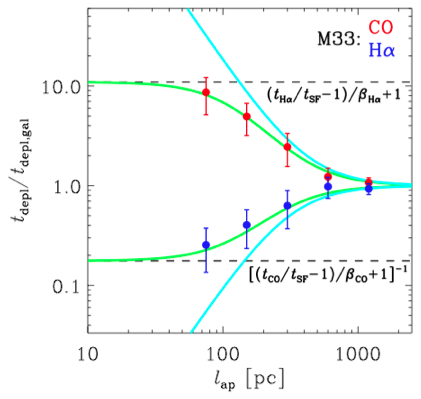| EPoS Contribution |
|
An Uncertainty Principle for Star Formation - Putting direct constraints on the physics of cloud evolution, star formation and feedback
Diederik Kruijssen MPA, Garching, DE | |
| There has been a flurry of recent literature on how galactic star formation (SF) relations develop substantial scatter or even change form when considered below a certain spatial scale. In this talk, I will quantify how this behaviour should be expected due to the incomplete statistical sampling of independent star-forming regions. I will present a simple uncertainty principle for SF, which can be used to predict and interpret the failure of galactic SF relations on small spatial scales. I show how the scatter and bias of SF relations are sensitive to the physical size and time-scales involved in the SF process. As a result, this new formalism provides a powerful tool to determine ill-constrained quantities such as the cloud lifetime and the rapidity of SF. An illustration is given in the Figure below. Using multiple gas tracers, it also allows one to map the density evolution of the ISM towards SF as a function of absolute time. In the ALMA era, this technique will enable the detailed characterisation of the SF process on the cloud scale, using galaxy-scale observations. I will present the first results of applying the uncertainty principle to observations, as well as some preliminary results from numerical simulations. Thanks to its general form, the uncertainty principle can also be applied to other astrophysical systems, e.g. addressing the time-evolution of star-forming cores, protoplanetary discs, or galaxies and their nuclei. | |
 | |
| Caption: Relative change of the gas depletion time (defined as tdepl = Mgas/SFR) as a function of aperture size when focussing on gas peaks (top) or stellar peaks (bottom) within the nearby flocculent spiral galaxy M33. The largest deviation occurs for small apertures. Red and blue dots with error bars show CO(1-0) (gas) and Halpha (stars) observations of M33 by Schruba et al. (2010). The green curves show the uncertainty principle of Kruijssen & Longmore (2014). The asymptotic values of tdepl at small aperture sizes are set by the duration for which the gas (tCO) and stellar (tHalpha) tracers are visible, as well as their overlap tSF (see the black dashed lines and labels). Because tHalpha is known from stellar population modelling, this allows the direct measurement of tCO and tSF. | |
| Collaborators: S. Longmore, LJMU, UK A. Schruba, MPE, DE |
Key publication
Suggested Sessions: Molecular Clouds |

